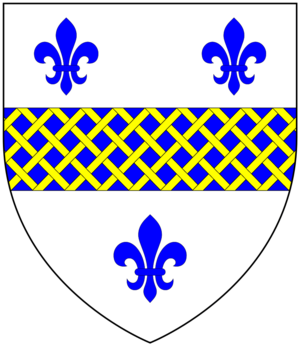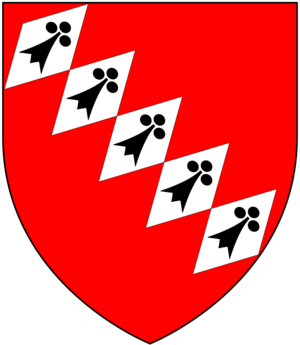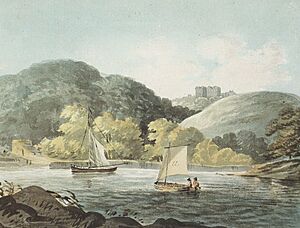John Hele (died 1608) facts for kids
Sir John Hele (born around 1541, died 1608) was an important lawyer and judge from Wembury in Devon, England. He was known as a "serjeant-at-law," which was a very high legal position. He also served as a Member of Parliament for Exeter and was the city's main legal officer, called the Recorder of Exeter, from 1592 to 1605.
Sir John Hele was considered one of Devon's "Worthies" by a famous biographer named John Prince. He built an amazing house in Wembury, which was described as one of the grandest homes in western England. It was known for its beautiful design, large size, and high cost. Sadly, this magnificent house was already a ruin by the 1700s and was completely taken down in 1803. Sir John also started a hospital for boys in Plymouth. You can still see his monument and a statue of him in Wembury Church today.
Contents
Sir John Hele's Family Background
Sir John Hele was born around 1543. He was the sixth son of Nicholas Hele from South Hele in Devon. His mother was Margery Dune, from Holsworthy.
His mother later married Ellis Warwick. Ellis Warwick had a daughter from an earlier marriage, Mary Warwick, who would later become Sir John Hele's wife. One of Sir John's older brothers, Thomas Hele, became the Sheriff of Devon in 1600. The Hele family originally came from an area called Hele in the parish of Cornwood in Devon.
Sir John Hele's Career in Law and Politics
Sir John Hele began his legal studies at the Inner Temple, which was a famous law school in London. He worked his way up to become a senior lawyer there.
He was elected as a Member of Parliament for Exeter and served from 1592 to 1601. At the same time, he was the Recorder of Exeter, a key legal role for the city, from 1592 to 1606.
In 1594, Hele became a "serjeant-at-law," a very important type of lawyer. By 1602, he was appointed "Queen's Serjeant" to Queen Elizabeth I. When King James I took the throne in 1603, Sir John's appointment was renewed, and he was made a knight. In 1603, he was involved in the trial of the famous explorer Sir Walter Raleigh. In 1608, due to his age, Sir John Hele was excused from his duties as a serjeant.
Sir John Hele's Marriage and Children

Sir John Hele married Mary Warwick, who was also his step-sister. She was the daughter of Ellis Warwick from Holbeton and St Budeaux in Devon. Mary died in 1571.
The family crest of the Warwicks can be seen on Sir John Hele's monument in Wembury Church. It shows a blue band with gold knots and three blue fleur-de-lys symbols on a silver shield.
Sir John and Mary had eight sons and two daughters. Statues of his children kneeling are part of his monument in Wembury Church. Their children included:
- Sir Warwick Hele (1568–1626): He was the eldest son and inherited his father's estate at Wembury. He also became a Member of Parliament and Sheriff of Devon.
- John Hele (died 1605): He was the second son and also served as a Member of Parliament for Plympton Erle.
- Sir Francis Hele (died 1623): He was the fourth son and was knighted in 1608. His son, Sir John Hele (1610–1648), inherited the Wembury estate from his uncle Sir Warwick Hele. Sir John's only daughter, Jane Hele, later married Sir Edward Hungerford.
- Philippa Hele: She married Sir Reginald Mohun, 1st Baronet.
Challenges and Reputation
Sir John Hele had a good reputation until about 1600. However, he faced some difficulties later on. He was involved in lending money, and his efforts to get loans repaid led to problems with powerful people, including Sir Thomas Egerton.
Hele also lost a lot of money when his ally, Robert Devereux, 2nd Earl of Essex, faced legal trouble in 1601. He was also owed a large sum by Henry Brooke, 11th Baron Cobham. When Cobham was involved in a political plot in 1603, some people thought Hele used his legal position to get his money back.
Sir William Dethick, a high-ranking official, accused Hele of acting violently in public. The Privy Council (a group of royal advisors) investigated Hele in 1604. The case went to the Star Chamber, a special court, which decided that Hele had not followed proper legal procedures in dealing with Cobham. As a result, he was temporarily removed from his job, fined, and put in prison for six weeks.
Sir John Hele's Properties
After earning a lot of money, Sir John Hele bought land at Wembury, near Plymouth, in Devon. This is where he built his grand mansion. He also owned a house in Kew and land in Warwickshire. He bought the manor of Yealmpton in Devon and the estate of Orcheton, Modbury.
Death and Burial
Sir John Hele passed away on June 4, 1608. He was buried in Wembury Church, where his monument can still be seen. The monument includes statues of him and his children. The Latin inscription on it says:
"Here lies John Hele, Knight, Serjeant-at-Law to the most Serene Lady Queen Elizabeth and to James King of Great Britain, who departed on the fourth day of June in the year of Our Lord 1608, in the year of his age 66."
His will was officially approved on October 1, 1608.




